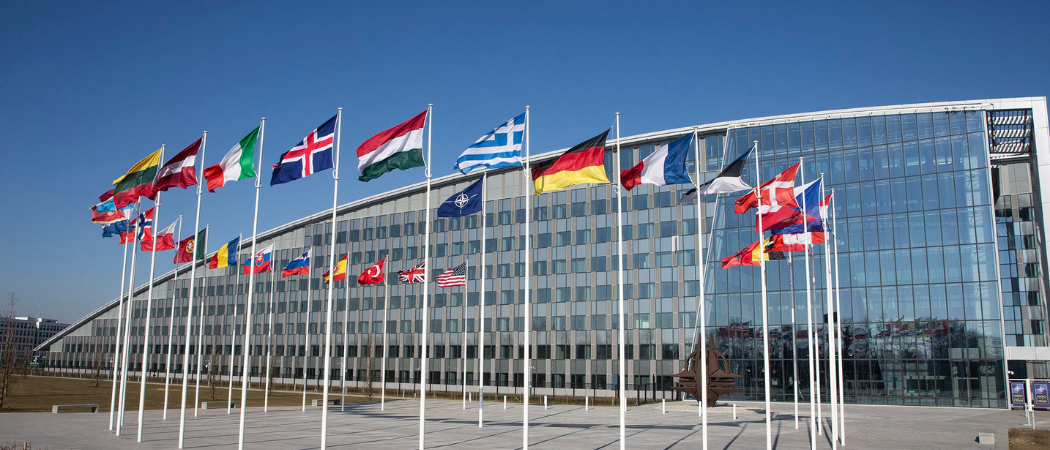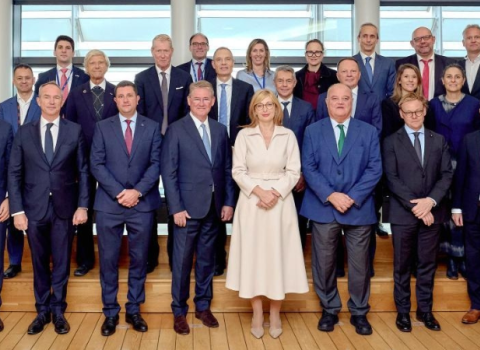Drawn by the generous terms of NATO’s Diana accelerator and mobilised by the war in Ukraine, start-ups in central and eastern Europe are opening up to adapting their technologies for use in defence

NATO's headquarters in Brussels, Belgium. Photo: NATO / Flickr
NATO’s drive to boost links with civilian tech companies has a high-profile presence in Estonia, with the Defence Innovation Accelerator for the North Atlantic (Diana) having a regional hub in Tallinn, where the Tehnopol Startup Incubator is among the five centres leading Diana’s pilot phase. This makes the local ecosystem a bellwether for NATO’s reception in central and eastern Europe, and the openness of start-ups to explore defence applications of technologies they are developing for civilian use.
For Vaido Mikheim, deep tech project lead at Startup Estonia, the reaction to Diana has been a combination of excitement at the possibilities and questions about what it all means. “Historically, the defence sector has been quite closed, so everyone wants to know how dual use and other aspects of the programme will play out,” he said. There has also been a little impatience. “The news has been out for more than a year and a half, and it is only launching now. But mostly there has been positive anticipation.”
Plans to launch Diana and the complementary NATO Innovation Fund were agreed at a NATO summit in 2021. Diana is intended to foster transatlantic cooperation on critical technologies, promote interoperability among allied forces, and harness civilian innovation by engaging with academia and the private sector. Meanwhile, the €1 billion innovation fund will support companies with dual-use technologies of potential application to defence and security, including those emerging from Diana.
Since 2021 the Russian invasion of Ukraine has significantly changed the context for defence innovation. This is proving to be a determining factor in how NATO’s initiatives are being received in central and eastern Europe.
“We have experienced a mind-change in the past year, since the war broke out, and a lot of start-ups that weren’t thinking previously of dual use, or of the defence sector at all, now do so,” said Kadri Tammai, head of Tehnopol Startup Incubator.
This change in attitude can also be seen among investors. “I see defence as part of environmental, social, and governance investing,” said Petr Šíma, a partner at DEPO Ventures in Prague, which manages angel funds and an international network of angel investors. “We need to be able to protect ourselves, and the situation we are in now will not disappear in five years. It will be with us for quite a long time.”
Tip of the iceberg
Diana launched a set of pilot challenges in June, covering energy resilience, secure information sharing, and sensing and surveillance. When the deadline passed in August, more than 1,300 applications had been received from across the NATO alliance. This is just the tip of the iceberg when it comes to interest in the initiative.
“We know that a lot of companies that would like to join Diana in the future didn’t apply this year, because the challenges were quite specific and not necessarily a good fit for them,” Tammai said.
From the applicants, around 30 start-ups will be selected to join one of the five accelerators, Tehnopol; Deep Tech Lab Quantum in Copenhagen; the Pacific Northwest Mission Acceleration Centre in Seattle; MassChallenge in Boston; and the Takeoff Diana Accelerator in Turin.
Evaluations are being carried out centrally, and the hosting incubators should find out soon which companies will be joining them. Applicants could express a preference, but will be assigned to an accelerator according to local strengths. A period of contract negotiation will follow, with the successful candidates likely to be announced before the end of the year.
Meanwhile, a management team was appointed to run the NATO innovation fund in July, with the first investments expected to be announced before the end of the year.
Diana and the NATO investment fund are particularly significant for Estonia, given the limited funding available locally. “The NATO Diana offer is so good that people think there has to be a catch somewhere, but so far no-one has found one,” said Mikheim.
In addition to the coaching in an accelerator, the 30 or so start-ups accepted into the first phase of Diana receive non-dilutive grants of €100,000, with no demands made on the company’s intellectual property. A second phase will single out 3 - 6 companies to scale-up and demonstrate their technologies, receiving a further €300,000.
The network of R&D centres behind Diana will also be significant for Estonia, and for other countries in central and eastern Europe with limited domestic resources. “Now you have fast-track access to infrastructure and funding, and potentially to industry veterans and mentors,” said Mikheim. “This will provide an excellent opportunity for the local start-up community, but only time will tell how they can capitalise on it.”
In addition, Diana will foster the development of networks. “This mix and mingle between international teams will help start-ups get an understanding of how teams from different places and different cultures operate,” said Mikheim. “That will be invaluable, particularly for the central and eastern European region, where there is a shorter history of such exchanges than in the west or the US.”
Learning curve
The launch of Diana has involved a learning curve for start-ups in central and eastern Europe, where it has taken a while for the message to get through that this is an initiative oriented towards civilian start-ups with dual use technologies, rather than those already working in defence.
“In the US, the concept of dual use is well understood by the majority of start-ups, but that is not necessarily the case in this region,” said Tammai. “Here, start-ups see themselves are either in defence or in the civil sector.”
Šíma thinks that start-ups need to be more open-minded about dual use technologies. “If we talk about defence tech it doesn’t have to be weapons, it can be many other things, such as cyber, that can be used for defence,” he said. Start-ups also need to recognise the scale of the opportunity. “European armies, and global armies, are huge corporate clients.”
Getting to grips with the implications of dual use will be at the heart of the Diana programme. It will have a commercial track that will be familiar from other acceleration programmes, for example covering product development, market development, and how to design a scalable business model. This will be complemented by examining the specificities of defence markets, both in Europe and the US, and issues such as export controls and how to protect intellectual property when patenting would require sensitive information to be disclosed.
While this will set the companies up to address defence markets, it does not presuppose that this will be their first priority. “It could easily happen that commercialisation will happen first on the civilian side, and then defence will follow,” Tammai said.
This is something that will be new for a lot of start-ups. “Not many people have considered how a dual use technology can be commercialised,” Mikheim said. “Where will you commercialise the product first, on the civil side or on the defence side? And what sort of boundaries or rules need to put in place?”
For example, if there has been an investment from the defence side, how will it carry over to the civil side? And if there is a follow-up investment from the civil side, how will that work with the kind of non-disclosure agreements common in defence? “This will involve a significant learning curve for all concerned,” said Mikheim.
The war in Ukraine may have significant influence on these questions. “It’s unfortunate, but for a defence or military tech start-up, Ukraine is the perfect testing ground,” Mikheim said. “It’s a sombre thought, but if you can validate your product, service or solution there, today, then it is proven, literally in the field. And that might push some of the solutions down the military route first.”
Pivot when necessary
Adjustments are likely on both sides as civilian start-ups start to work with NATO and the defence sector. “Start-ups are often agile and pivot when necessary, so there are very few rules, but now they are entering into a space dictated by rules, and no-one is sure how this will play out,” Mikheim said.
There is also a need to adapt on the defence side, with a number of military bases set to join Diana’s network of test centres. “The majority of these bases have never welcomed civilian start-ups, so we have to work out how that will happen in practice,” Tammai said.
Meanwhile, she is hoping that Diana’s focus on dual use will help transform the investment ecosystem in the region. “Previously we’ve faced a lot of questions from venture capital funds, which do not necessarily want to invest in defence,” she said. “But now it is dual use, and commercialisation can happen on the civilian side as well, there is a lot more interest from investors.”
The NATO innovation fund should also have a positive effect. “A €1 billion fund focused on dual use companies brings a lot of money to the market, and that will act as a risk mitigator for private investors as well,” she said.
As an angel, Šíma is already happy to look at the dual-use and defence sector. “But the whole ecosystem needs to be involved,” he said. “We need early stage and later stage investors, and we need corporates and armies to be ready to invest, so there is still quite a lot of work to do.”
More work will also be required on how governments collaborate with start-ups on defence. Some already have programmes that complement NATO’s initiatives. “In Estonia, the Ministry of Defence has held a competition for innovative defence solutions, which start-ups can apply to, win equity free grants and work with the defence forces,” Tammai said. “Many other ministries of defence are moving in this direction as well, and meeting start-ups half-way.”
But more needs to be done when it comes to procurement. “We already have a legal basis for innovative procurement, but governments are not necessarily using these instruments, which would allow more rapid adoption of new technologies,” she said.
Elsewhere in the Ecosystem…
- Vienna-based HeartBeat.bio has raised €4.5 million in pre-series A funding to further develop its heart drug discovery platform, comprising a scalable human heart organoid and AI-supported software for drug screening. The company was founded in 2021 to commercialise technology developed at the Austrian Academy of Science’s Institute of Molecular Biotechnology.
- Nu Quantum, a 2018 spin-out from the Cavendish Laboratory at Cambridge University, has raised £7 million in pre-series A funding to further develop scalable networking technology for quantum computers.
- The European Investment Bank signed a €40 million loan agreement with In Ovo, a 2013 spin-off from Leiden University that has developed a method for the early identification of the sex of eggs, enabling producers to select those that will hatch into laying hens, rather than culling unwanted male chicks.
Editor’s note: This article was updated 9 November 2023 to identify Kadri Tammai as 'head of Tehnopol Startup Incubator' instead of 'head of Tehnopol'





 A unique international forum for public research organisations and companies to connect their external engagement with strategic interests around their R&D system.
A unique international forum for public research organisations and companies to connect their external engagement with strategic interests around their R&D system.